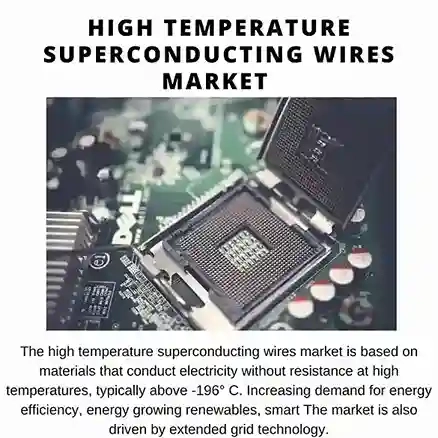
- Get in Touch with Us

Last Updated: Apr 27, 2025 | Study Period: 2024-2030
The high temperature superconducting wires market is based on materials that conduct electricity without resistance at high temperatures, typically above -196° C. Increasing demand for energy efficiency, energy growing renewables, smart The market is also driven by extended grid technology. Major applications include power transfer, magnetic levitation transport, medical imaging (such as MRI), and particle accelerators. The leading players are the United States, Sumitomo Electric Technology, which is recognized for their significant innovation, and growing infrastructure. Integrating HTS technologies and increasing the cost and increasing the performance demonstration coincidentally, in the next decade.

Major applications of HTS cables include electrical communication systems, magnetic levitation (maglev) navigation, medical imaging technologies such as MRI machines, and high-speed particles for use in scientific research
Key players in the industry include American Superconductor, Sumitomo Electric, and Superconductor Technologies, recognized for their innovative strategies and large market share These companies are actively involved in research and development to provide HTS products has improved efficiency and reduced manufacturing costs. Economic development means increasing emphasis on developing cost-effective manufacturing facilities and infrastructure that facilitates the integration of HTS technologies into existing systems along with industry leadership and research institutions increasing collaboration to stimulate innovation and expand areas of application.
The high temperature superconducting wires market includes a variety of advanced materials that exhibit zero electrical resistance at high temperatures, typically above -196°C. This remarkable property for these wires yields unparalleled power efficiency in a range of sophisticated applications. HTS cables are essentially used in power transmission, where they significantly reduce energy losses, and thus provide the overall efficiency of the electrical grid is increased They are also key to magnetic levitation (maglev) transportation technology, improving frictionless transportation and energy efficiency
In the medical field, HTS fibers are critical for the operation of magnetic resonance imaging (MRI) devices, providing strong magnetic fields needed for high-resolution imaging. In addition, these fibers are used in particle accelerators and other scientific research areas. Driven by high demand, the HTS cable market is poised for significant growth, driven by technological advances and increased focus on sustainable energy solutions.
In the medical field, HTS wires are integral to the operation of magnetic resonance imaging (MRI) machines, providing the strong magnetic fields necessary for high-resolution imaging, which is vital for accurate diagnostics. Furthermore, HTS wires are used in particle accelerators and other scientific research applications, where they facilitate the generation of powerful magnetic fields required for advanced experimental setups.
As the demand for energy-efficient solutions and innovative technologies continues to grow, the high-temperature superconducting wires market is poised for significant expansion. Factors such as advancements in material science, increased investment in renewable energy, and the push for smart grid technologies are driving this market forward, positioning HTS wires as a critical component in the future of energy and transportation systems.
The global push for more efficient power systems is driving the adoption of high-voltage transmission (HTS) cables. These lines greatly reduce energy losses during transmission, making them essential for modern power lines.
Increased reliance on renewable energy sources such as wind and solar requires advanced energy transmission solutions. HTS lines simplify complex power delivery, and help connect intermittent renewables to the grid.
New trends in materials science and manufacturing are improving efficiency and reducing the cost of HTS cables. These technological improvements are crucial for widespread adoption in various industries.
The increasing popularity of electric vehicles and magnetic levitation (maglev) transportation systems is increasing the demand for lightweight and efficient solutions for overloading, fueling the growth of the market
Sound policies and budgets by governments across the globe to promote clean energy technologies are creating favorable conditions for the HTS wire market.

New materials and improved superconducting techniques improve the performance and reliability of HTS cables New research aims to develop materials that can operate at higher temperatures and lie in mechanical properties with good characteristics.
As the demand for HTS fibers increases, manufacturers are increasingly focusing on reducing manufacturing costs through productivity improvements. Techniques such as roll-to-roll production and coated conductor technology are in vogue, enabling increased economies of scale.
The need for efficient energy transmission solutions is driving the hybridization of HTS lines with renewable energy. HTS technology is being used in energy storage systems and smart grids to increase grid reliability and performance.
In transportation, HTS cables are gaining traction, especially in magnetic levitation (maglev) trains and electric vehicles (EVs). This trend is based on the need for effective sub-solutions that can improve the overall system performance.
Significant investments are being made in research and development to find new applications and improve existing technologies. Private sector and government agencies are supporting projects aimed at improving the capacity of HTS lines.
| Sl no | Company | Product Description | Analyst View | ||||||||||
| 1 2 3 | American Superconductor Superconductor technologies Bruker Corporation | Second-generation high-temperature superconducting wire designed for power applications.
Wire designed to support high-current applications in scientific research. | Responds to growing demand for efficient power transmission systems. Targets specialized applications in medical imaging and research. Developed to meet rising demands in scientific research facilities. |
By Application
By Material Type
By Geography
By Manufacturing Technology
| Sl.no | TOPIC |
| 1 | Market Segmentation |
| 2 | Scope of the report |
| 3 | Research Methodology |
| 4 | Executive Summary |
| 5 | Introduction |
| 6 | Insights from Industry stakeholders |
| 7 | Increasing Demand for Energy Efficiency |
| 8 | Expansion of Renewable Energy Integration |
| 9 | Emphasis on high temperature superconducting wires |
| 10 | Sustainability and Environmental Impact of HTS Technology |
| 11 | Impact of Smart Grids on HTS Adoption |
| 12 | Disruptive innovation in the Industry |
| 13 | Technology trends in the Industry |
| 14 | Consumer trends in the industry |
| 15 | Recent Production Milestones |
| 16 | Component Manufacturing in US, EU and China |
| 17 | Average B-2-B selling price in past 5 years |
| 18 | Competition from substitute products |
| 19 | New product development in past 12 months |
| 20 | Market Size, Dynamics and Forecast by App;ication , 2024-2030 |
| 21 | Market Size, Dynamics and Forecast by Manufacturing Technology , 2024-2030 |
| 22 | Market Size, Dynamics and Forecast by Material Type , 2024-2030 |
| 23 | Market Size, Dynamics and Forecast by Geography , 2024-2030 |
| 24 | Competitive Landscape |
| 25 | M&A in past 12 months |
| 26 | Growth strategy of leading players |
| 27 | Market share of vendors, 2023 |
| 28 | Company Profiles |
| 29 | Unmet needs and opportunity for new suppliers |
| 30 | Conclusion |